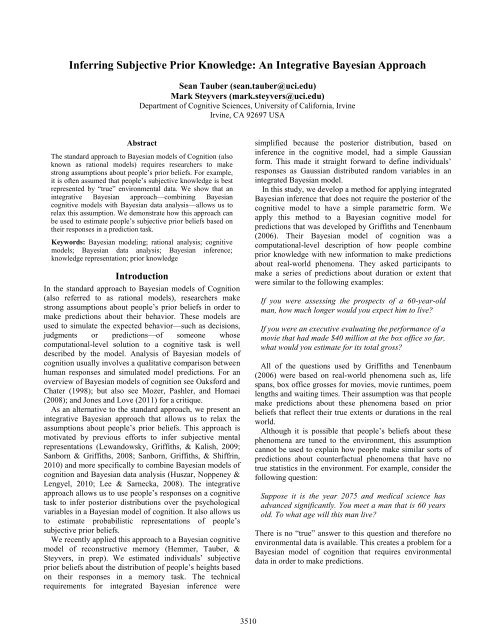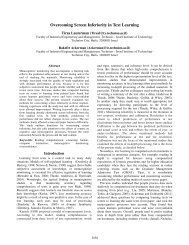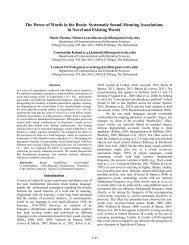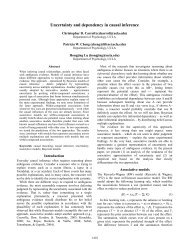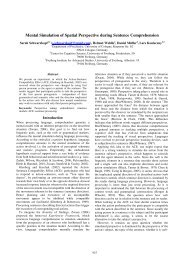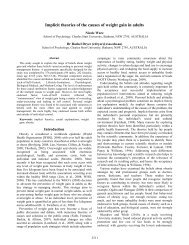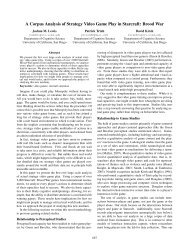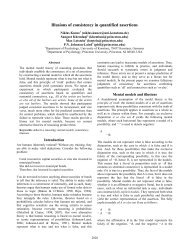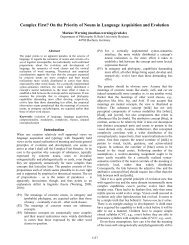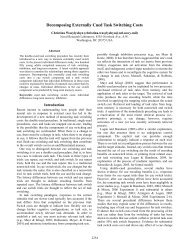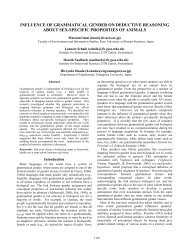Inferring Subjective Prior Knowledge: An ... - MindModeling.org
Inferring Subjective Prior Knowledge: An ... - MindModeling.org
Inferring Subjective Prior Knowledge: An ... - MindModeling.org
Create successful ePaper yourself
Turn your PDF publications into a flip-book with our unique Google optimized e-Paper software.
<strong>Inferring</strong> <strong>Subjective</strong> <strong>Prior</strong> <strong>Knowledge</strong>: <strong>An</strong> Integrative Bayesian Approach<br />
Sean Tauber (sean.tauber@uci.edu)<br />
Mark Steyvers (mark.steyvers@uci.edu)<br />
Department of Cognitive Sciences, University of California, Irvine<br />
Irvine, CA 92697 USA<br />
Abstract<br />
The standard approach to Bayesian models of Cognition (also<br />
known as rational models) requires researchers to make<br />
strong assumptions about people’s prior beliefs. For example,<br />
it is often assumed that people’s subjective knowledge is best<br />
represented by “true” environmental data. We show that an<br />
integrative Bayesian approach—combining Bayesian<br />
cognitive models with Bayesian data analysis—allows us to<br />
relax this assumption. We demonstrate how this approach can<br />
be used to estimate people’s subjective prior beliefs based on<br />
their responses in a prediction task.<br />
Keywords: Bayesian modeling; rational analysis; cognitive<br />
models; Bayesian data analysis; Bayesian inference;<br />
knowledge representation; prior knowledge<br />
Introduction<br />
In the standard approach to Bayesian models of Cognition<br />
(also referred to as rational models), researchers make<br />
strong assumptions about people’s prior beliefs in order to<br />
make predictions about their behavior. These models are<br />
used to simulate the expected behavior—such as decisions,<br />
judgments or predictions—of someone whose<br />
computational-level solution to a cognitive task is well<br />
described by the model. <strong>An</strong>alysis of Bayesian models of<br />
cognition usually involves a qualitative comparison between<br />
human responses and simulated model predictions. For an<br />
overview of Bayesian models of cognition see Oaksford and<br />
Chater (1998); but also see Mozer, Pashler, and Homaei<br />
(2008); and Jones and Love (2011) for a critique.<br />
As an alternative to the standard approach, we present an<br />
integrative Bayesian approach that allows us to relax the<br />
assumptions about people’s prior beliefs. This approach is<br />
motivated by previous efforts to infer subjective mental<br />
representations (Lewandowsky, Griffiths, & Kalish, 2009;<br />
Sanborn & Griffiths, 2008; Sanborn, Griffiths, & Shiffrin,<br />
2010) and more specifically to combine Bayesian models of<br />
cognition and Bayesian data analysis (Huszar, Noppeney &<br />
Lengyel, 2010; Lee & Sarnecka, 2008). The integrative<br />
approach allows us to use people’s responses on a cognitive<br />
task to infer posterior distributions over the psychological<br />
variables in a Bayesian model of cognition. It also allows us<br />
to estimate probabilistic representations of people’s<br />
subjective prior beliefs.<br />
We recently applied this approach to a Bayesian cognitive<br />
model of reconstructive memory (Hemmer, Tauber, &<br />
Steyvers, in prep). We estimated individuals’ subjective<br />
prior beliefs about the distribution of people’s heights based<br />
on their responses in a memory task. The technical<br />
requirements for integrated Bayesian inference were<br />
simplified because the posterior distribution, based on<br />
inference in the cognitive model, had a simple Gaussian<br />
form. This made it straight forward to define individuals’<br />
responses as Gaussian distributed random variables in an<br />
integrated Bayesian model.<br />
In this study, we develop a method for applying integrated<br />
Bayesian inference that does not require the posterior of the<br />
cognitive model to have a simple parametric form. We<br />
apply this method to a Bayesian cognitive model for<br />
predictions that was developed by Griffiths and Tenenbaum<br />
(2006). Their Bayesian model of cognition was a<br />
computational-level description of how people combine<br />
prior knowledge with new information to make predictions<br />
about real-world phenomena. They asked participants to<br />
make a series of predictions about duration or extent that<br />
were similar to the following examples:<br />
If you were assessing the prospects of a 60-year-old<br />
man, how much longer would you expect him to live?<br />
If you were an executive evaluating the performance of a<br />
movie that had made $40 million at the box office so far,<br />
what would you estimate for its total gross?<br />
All of the questions used by Griffiths and Tenenbaum<br />
(2006) were based on real-world phenomena such as, life<br />
spans, box office grosses for movies, movie runtimes, poem<br />
lengths and waiting times. Their assumption was that people<br />
make predictions about these phenomena based on prior<br />
beliefs that reflect their true extents or durations in the real<br />
world.<br />
Although it is possible that people’s beliefs about these<br />
phenomena are tuned to the environment, this assumption<br />
cannot be used to explain how people make similar sorts of<br />
predictions about counterfactual phenomena that have no<br />
true statistics in the environment. For example, consider the<br />
following question:<br />
Suppose it is the year 2075 and medical science has<br />
advanced significantly. You meet a man that is 60 years<br />
old. To what age will this man live?<br />
There is no “true” answer to this question and therefore no<br />
environmental data is available. This creates a problem for a<br />
Bayesian model of cognition that requires environmental<br />
data in order to make predictions.<br />
3510
Environmental Statistics as <strong>Prior</strong> <strong>Knowledge</strong><br />
Researchers can use Bayesian models of cognition to<br />
simulate the responses that people would make if their<br />
computational-level solution to the prediction problem is<br />
well described by the model. This process requires that the<br />
model includes representations of the prior knowledge<br />
people have about the phenomena being predicted.<br />
Researchers can represent prior knowledge in their models<br />
by collecting real-world environmental statistics and using<br />
them in their models as a stand-in for the subjective prior<br />
knowledge of individuals (Griffiths & Tenenbaum, 2006<br />
Hemmer & Steyvers, 2009a; Hemmer & Steyvers, 2009b).<br />
Representing prior knowledge in this manner is based on the<br />
assumption that our knowledge and representations about<br />
real-world phenomena are based on actual exposure to these<br />
phenomena in the environment. A researcher’s best guess at<br />
a participant’s knowledge is that it reflects, on average, the<br />
actual statistics of that phenomenon in the environment.<br />
Standard Qualitative <strong>An</strong>alysis<br />
In the standard approach to Bayesian cognitive modeling,<br />
researchers qualitatively compare model predictions to<br />
people’s responses. The values of psychological<br />
parameters—which represent aspects of cognition that are<br />
“in people’s heads”—are manually specified or estimated<br />
with non-Bayesian methods. For a critique of non-Bayesian<br />
analysis of Bayesian models, see Lee (2011). The researcher<br />
usually encodes subjective prior knowledge in the model<br />
using empirical priors (based on environmental data) or by<br />
specifying parametric priors with psychological parameters.<br />
A limitation of this method is that researchers do not<br />
apply Bayesian inference techniques to participant response<br />
data, in order to make inferences about the prior knowledge<br />
and psychological parameters represented in the model. It<br />
does not allow for the possibility that participants’ prior<br />
knowledge could be different from the form assumed by the<br />
researcher. Furthermore, a model that requires prior<br />
knowledge from real-world data cannot be used to generate<br />
predictions if the researcher is unable to encode this data in<br />
the model. For example, Griffiths’ and Tenenbaum’s (2006)<br />
model cannot be used to generate predictions for the<br />
counterfactual future life spans question; even though it<br />
involves the same sort of task as the factual prediction<br />
questions.<br />
Quantitative <strong>An</strong>alysis: <strong>An</strong> Integrative Bayesian<br />
Approach<br />
The limitations of the qualitative approach can be<br />
addressed by reframing a Bayesian model of cognition as a<br />
generative process for human response data. Researchers<br />
can then use an integrative Bayesian approach to make<br />
inferences about the subjective aspects of the cognitive<br />
model.<br />
A Bayesian Model of Cognition for Predictions Griffiths<br />
and Tenenbaum (2006) had people make simple predictions<br />
Figure 1. Graphical model (observer perspective)<br />
about the duration or extent of real-world phenomena. For<br />
example, when told that a man was currently 60 years old,<br />
people had to predict the age to which he would live. We<br />
refer to the value that is presented in the question as and to<br />
the person’s prediction as . So if a person predicted<br />
that the man would live to be 8o years old, then we would<br />
have and .<br />
The Bayesian model of cognition proposed by Griffiths<br />
and Tenenbaum used nonparametric environmental priors<br />
for . We use a modified version of their model in<br />
which has a parametric prior that is Normal, Erlang or<br />
Pareto distributed. We add a switch that selects which<br />
parametric form is used for the prior.<br />
Figure 1 is a graphical representation of our cognitive<br />
model for duration and extent from the perspective of the<br />
person making predictions (the observer). Shaded nodes<br />
represent variables that contain information that is known to<br />
the observer. Unshaded nodes contain information that is<br />
unknown to the observer.<br />
The model depicts an observer’s subjective model of the<br />
conditional dependencies between total duration/extent<br />
of phenomena of different types —which are<br />
determined by the form of the observer’s prior knowledge<br />
for the domain. The vector parameterizes prior<br />
distribution types such that parameterize Normal,<br />
Erlang and Pareto types, respectively. We specify the prior<br />
distribution as:<br />
{<br />
( )<br />
( )<br />
( )<br />
(1)<br />
The time or duration from which the observer must predict<br />
is equally likely for all possible values<br />
. We implemented this in the model by placing a<br />
uniform prior on :<br />
( ) (2)<br />
When presented with a prediction question with value , we<br />
assume that observers access the relevant prior knowledge<br />
of by determining the prior type and the parameter<br />
3511
values and then infer a posterior distribution<br />
( | ) that is described using Bayes’ rule:<br />
( | )<br />
{<br />
( | ) ( | )<br />
(3)<br />
where,<br />
( | ) {<br />
( | )<br />
( | )<br />
( | )<br />
(4)<br />
Finally, the observer provides a prediction for the total<br />
extent or duration. This response is based on the posterior<br />
distribution ( | ), and could be related to the<br />
posterior in a number of ways. The response could be a<br />
sample from the posterior,<br />
( | ) (5)<br />
or it could be a function of the posterior such as the median,<br />
mean or mode. Griffiths and Tenenbaum (2006) modeled<br />
predictions as the median of the posterior. We assume that<br />
each response is based on a single sample from the<br />
posterior. This assumption provides a technical<br />
simplification for modeling how people generate a response<br />
from the posterior distribution. We will not explore the<br />
theoretical implications of this assumption in depth;<br />
however, there is evidence supporting a response model that<br />
is based on limited samples from a posterior (Vul,<br />
Goodman, Griffiths & Tenenbaum, 2009).<br />
Applying Bayesian Data <strong>An</strong>alysis to the Bayesian Model<br />
of Cognition The goal of the researcher is to apply<br />
Bayesian data analysis to the Bayesian model of cognition<br />
in order to infer the values of and given and observer<br />
predictions about . This requires an integrative<br />
application of Bayesian inference from the perspective of<br />
the researcher. Each and every value of and for which<br />
the researcher wishes to evaluate the posterior likelihood<br />
requires Bayesian inference of the posterior likelihood of<br />
the observer’s response in the rational model given the<br />
values of and .<br />
From the perspective of the researcher, the responses<br />
provided by an observer are the result of a generative<br />
process that encapsulates an application of Bayesian<br />
inference to a Bayesian model of cognition (fig. 1) resulting<br />
in a posterior distribution (Eq. 3) from which the result is<br />
sampled. We call this generative process a Bayesian<br />
Inference and Response Process (BIRP) and define it as a<br />
probability distribution with likelihood function:<br />
Figure 2. Graphical model (researcher perspective)<br />
( | ) {<br />
( | ) ( | )<br />
(6)<br />
Figure 2 shows a graphical model from the perspective of<br />
the researcher that incorporates a BIRP. In this model the<br />
original stimulus and the observer responses are data<br />
that is known to the researcher. The form of the prior<br />
distribution used by the observer is indexed by , and the<br />
parameters for the observer’s possible prior distributions are<br />
all latent (unobserved) variables for which posterior<br />
distributions will be inferred. Observer responses are<br />
generated as samples from the BIRP:<br />
( ) (7)<br />
The researcher must place suitable hyper priors on the latent<br />
prior type and latent parameters for the observer prior<br />
distributions and . We define the deterministic<br />
vector 〈( ) 〉 for the purpose of notational<br />
compactness.<br />
Experiment<br />
We described an integrative Bayesian approach that allows<br />
us to make inferences about people’s subjective beliefs<br />
based on their responses in a prediction task. We ran an<br />
experiment in order to collect people’s predictions for<br />
several of the same questions used by Griffiths and<br />
Tenenbaum (2006). We also collected predictions for the<br />
counterfactual lifespans question.<br />
Method<br />
Participants<br />
A total of 25 undergraduates from the University of<br />
California, Irvine participated in the study and were<br />
compensated with partial course credit.<br />
Materials<br />
Prediction questions were presented to participants through<br />
a web-based survey. There were 8 different question types<br />
3512
life spans<br />
movie runtimes<br />
movie grosses<br />
poem lengths<br />
representative terms<br />
pharaoh reigns<br />
phone wait times<br />
future life spans<br />
Figure 3. Posterior distributions of people’s subjective prior types and parameter values from the researcher’s perspective. For<br />
each of the eight question types the subplot for the indicator variable shows the relative posterior probability for each of the prior<br />
types (normal, Erlang, or Pareto). The remaining subplots show the posterior distributions of the parameters for these prior types.<br />
Parameters that correspond to prior types with zero posterior probability are shown in gray.<br />
and 5 variations of each question. Each variation<br />
corresponded to 1 of 5 possible values of .The survey<br />
instructions and 7 of the questions were identical to those<br />
used by Griffiths and Tenenbaum (2006). For the<br />
unabbreviated questions and survey instructions, refer to<br />
Griffiths and Tenenbaum (2006). Below are abbreviated<br />
examples of each of the questions with all 5 of the possible<br />
values included: (1) Predict the age a man will live to if he<br />
is currently (18, 39, 61, 83, 96) years old; (2) Predict what<br />
the total box-office intake for a movie that has taken in ($1,<br />
$6, $10, $40, $100) so far; (3) Predict the length of a movie<br />
that has already been playing for (30, 60, 80, 95, 110)<br />
minutes; (4) Predict the total length of a poem from which<br />
you were just quoted line (2, 5, 12, 32, 67); (5) Predict the<br />
total time a pharaoh will be in power if he had already<br />
reigned for (1, 3, 7,11, 23) years in 4000 BC; (6) Predict the<br />
total years that a (1, 3, 7, 15, 31) year member of the U.S.<br />
House serve; (7) Predict how long you will be on hold if you<br />
have already been holding on the phone for (1, 3, 7, 11, 23)<br />
minutes. There was an eighth question that was not part of<br />
the Griffiths and Tenenbaum study: Suppose it is the year<br />
2075 and medical science has advanced significantly. You<br />
meet a man that is (18, 39, 61, 83, 96) years old. To what<br />
age will this man live?<br />
Procedure<br />
Each participant made a prediction about all 5 instances of<br />
the 8 different types of phenomena for a total of 40<br />
questions. Each prediction was based on one of the five<br />
possible values of . The questions were presented in a<br />
different random order for each participant. Only one<br />
question was presented on-screen at a time and participants<br />
entered their answer in a text-entry box before moving to<br />
the next question.<br />
Inference and Data <strong>An</strong>alysis<br />
Responses from each participant were considered for<br />
exclusion on a per question-type basis. If any of a<br />
participant’s five responses for one of the eight questiontypes<br />
were below the value of that was presented in the<br />
question, then all five of that participant’s responses for that<br />
question-type were excluded for analysis but their responses<br />
for other question-types were still included—as long as they<br />
passed the inclusion requirement above. The number of<br />
participants that were included in the analysis for each<br />
question-type was: 24 for life spans; 23 for box office<br />
intake; 23 for movie durations; 25 for poem lengths; 24 for<br />
pharaoh reigns; 20 for U.S. representative terms; and 25 for<br />
lifespans in the future.<br />
We aggregated participant responses for each question<br />
such that each response provided an additional data point for<br />
Bayesian analysis. We implemented a customized Markovchain<br />
Monte Carlo (MCMC) sampler to perform Bayesian<br />
inference using the researcher model. To complete the<br />
model, we used the following priors:<br />
( ) ( )<br />
( ) ( )<br />
( ) ( )<br />
Results<br />
Figure 3 shows a complete summary of the posterior<br />
distributions for the subjective prior types as well as the<br />
posteriors for the psychological variables that parameterized<br />
the subjective priors. We used people’s predictions to infer<br />
the posterior probability that their subjective prior<br />
knowledge for each domain was best characterized by a<br />
Normal, Erlang or Pareto distribution. Although the<br />
inference allowed for uncertainty about the form of the<br />
3513
elative probability<br />
Estimated subjective priors<br />
t total values<br />
Model predictions (environmental priors)<br />
predicted t total<br />
Model predictions (estimated subjective priors)<br />
t values<br />
Figure 4. Estimated subjective priors and model predictions. The first row shows our estimates of people’s subjective prior beliefs<br />
compared with the environmental distributions collected by Griffiths and Tenenbaum (2006). The bottom two rows overlay<br />
people’s actual responses (black marks) with the posterior predictive distributions (gray shaded areas) of the Bayesian cognitive<br />
models for new (unobserved) responses. The posterior predictive probabilities of responses for the environmental prior model<br />
(second row) and the estimated subjective prior model (third row) are proportional to the darkness of the gray areas.<br />
subjective prior—in which case some posterior probability<br />
would have been assigned to more than one of the possible<br />
forms—in every domain, all of the posterior mass was<br />
assigned to a single type of distribution.<br />
The top row of Figure 4 shows the estimated subjective<br />
priors that people used to make predictions in comparison to<br />
the true environmental distributions that were collected by<br />
Griffiths and Tenenbaum (2006). The estimated subjective<br />
distributions were generated by sampling a prior type and<br />
parameter values from the posterior distributions and then<br />
using them to generate a sample.<br />
Our estimates of people’s subjective priors for life spans,<br />
movie runtimes, movie grosses, poem lengths, U.S.<br />
representatives’ terms and pharaohs’ reigns are remarkably<br />
similar in form to the true environmental distributions. The<br />
subjective priors for life spans, movie runtimes and<br />
pharaohs’ reigns are shifted slightly to the right compared to<br />
the environmental distributions, suggesting that people’s<br />
prior knowledge for these domains has the same form as the<br />
environmental statistics but may not be tuned perfectly to<br />
the environment.<br />
People’s subjective prior for waiting times was estimated<br />
in the same manner as the other priors even though the<br />
environmental data was not available. The estimated<br />
subjective prior for waiting times was consistent with an<br />
Erlang form. Griffiths & Tenenbaum (2006) were unable to<br />
provide estimates of these posteriors using the standard<br />
qualitative analysis, but did use non-Bayesian methods to fit<br />
people’s responses and found that a prediction function<br />
based on a Power-Law (Pareto) prior provided the best fit. It<br />
is not immediately clear if our disagreement about the form<br />
of the subjective prior for phone waiting times is due to<br />
differences in our methodology or to differences in the<br />
predictions of our respective participants.<br />
A subjective prior for future life spans was estimated even<br />
though it is based on a counterfactual scenario and therefore<br />
has no true environmental distribution. This subjective prior<br />
appears to have a similar form to the prior for actual life<br />
spans, but is shifted to the right with an average life span of<br />
105.<br />
The bottom two rows of Figure 4 overlay people’s actual<br />
responses (black marks) with posterior predictive<br />
3514
distributions from the Bayesian cognitive model for new<br />
(unobserved) responses using the environmental prior<br />
(second row) and the estimated subjective prior (third row).<br />
The posterior predicitve distributions are generally similar<br />
for both the environmental prior model and the estimated<br />
prior model. There are some differences in the predictions<br />
of the models which are consistent with differences between<br />
the estimated and environmental priors. For example, the<br />
estimated prior for life spans did not capture an increased<br />
risk of death for infants and therfore the estimated model<br />
predicts less deaths at a young age than the environmental<br />
model does. This can likely be attributed to the limited<br />
range of ages (18 to 96 years) presented to participants. The<br />
estimated models for movie grosses and representatives’<br />
terms tend to predict higher values than the environmental<br />
model, which is consitent with the tendancy of some<br />
participants to overestimate these values.<br />
Discussion<br />
We demonstrated that an integrative Bayesian approach—<br />
combining Bayesian data analysis with Bayesian models of<br />
cognition—allowed us to estimate people’s subjective prior<br />
knowledge based on their responses in a simple prediction<br />
task. This approach allowed us to relax the assumption that<br />
representations of people’s prior knowledge in a rational<br />
model should be veridical with environmental statistics.<br />
Although we did not require environmental data to apply<br />
an integrative Bayesian approach, having this data allowed<br />
us to compare our estimates of people’s subjective beliefs to<br />
real-world environmental data. We found that people’s<br />
beliefs about the phenomena in our study were similar in<br />
form to the environmental statistics, but that they showed<br />
some deviations. At least one of these deviations—related to<br />
infant mortality in the life spans question—likely resulted<br />
from the limited range of response data that the model used<br />
to estimate subjective priors. Other differences between the<br />
estimated and environmental priors seem more likely to be<br />
the result of deviations between people’s subjective beliefs<br />
and the environmental statistics. For example, some people<br />
tended to overestimate the total gross of movies and the<br />
lengths of representatives’ terms and pharaohs’ reigns. The<br />
integrative Bayesian approach is able to provide<br />
explanations and predictions that account for these human<br />
responses in a way that traditional rational analysis cannot.<br />
Furthermore, in situations where a Bayesian model of<br />
cognition requires representations of people’s prior beliefs<br />
and environmental data is unavailable or non-existent—like<br />
it was for telephone waiting times and future life spans in<br />
our study—an integrative Bayesian framework can still be<br />
used to infer subjective priors and make model predictions.<br />
Taking an integrative Bayesian approach opens the door<br />
for researchers to take advantage of all of the methods that<br />
have been developed for Bayesian analysis of cognitive<br />
process models (Lee, 2008) and apply these methods to<br />
Bayesian cognitive models. In addition to the estimation of<br />
subjective priors and psychological parameters, this method<br />
also allows for individual differences in subjective prior<br />
beliefs (Hemmer, et al., in prep). This is important because<br />
if people’s subjective priors are not tuned to the<br />
environment for a particular domain, then it is reasonable to<br />
assume that different people have different subjective priors.<br />
Acknowledgements<br />
Thank you to Michael Lee and James Pooley for helpful<br />
discussions; and to Tom Griffiths and Josh Tenenbaum for<br />
providing us with the environmental data that they collected.<br />
References<br />
Griffiths, T. L., & Tenenbaum, J. B. (2006). Optimal<br />
predictions in everyday cognition. Psychological Science,<br />
17, 767–773.<br />
Hemmer, P. & Steyvers, M. (2009a). A Bayesian account of<br />
reconstructive memory. Topics in Cognitive Science, 1(1),<br />
189–202.<br />
Hemmer, P. & Steyvers, M. (2009b). Integrating episodic<br />
memories and prior knowledge at multiple levels of<br />
abstraction. Psychonomic bulletin & review, 16(1), 80–7.<br />
Hemmer, P., Tauber, S., & Steyvers, M. (in preparation).<br />
Bayesian estimation in rational models.<br />
Huszár, F., Noppeney, U. & Lengyel, M. (2010). Mind<br />
reading by machine learning: A doubly Bayesian method<br />
for inferring mental representations. Proceedings of the<br />
32nd <strong>An</strong>nual Conference of the Cognitive Science Society.<br />
Jones, M. & Love, B.C. (2011). Bayesian fundamentalism<br />
or enlightenment? On the explanatory status and<br />
theoretical contributions of Bayesian models of<br />
cognition. Behavioral and Brain Sciences<br />
Lee, M. D. (2008). Three case studies in the Bayesian<br />
analysis of cognitive models. Psychonomic Bulletin &<br />
Review, 15, 1–15.<br />
Lee, M.D. (2011). In praise of ecumenical Bayes.<br />
Behavioral and Brain Sciences, 34, 206–207.<br />
Lee, M. D. & Sarnecka, B.W. (2010). A model of knowerlevel<br />
behavior in number-concept development. Cognitive<br />
Science, 34, 51–67.<br />
Mozer, M., Pashler, H., & Homaei, H. (2008). Optimal<br />
predictions in everyday cognition: The wisdom of<br />
individuals or crowds? Cognitive Science, 32, 1133–1147.<br />
Oaksford, M., & Chater, N. (Eds.). (1998). Rational models<br />
of cognition. Oxford: Oxford University Press.<br />
Sanborn, A. N., & Griffiths, T. L. (2008). Markov chain<br />
Monte Carlo with people. Advances in Neural<br />
Information Processing Systems 20.<br />
Sanborn, A. N., Griffiths, T. L., & Shiffrin, R. (2010).<br />
Uncovering mental representations with Markov chain<br />
Monte Carlo. Cognitive Psychology, 60, 63–106.<br />
Vul, E., Goodman, N.D., Griffiths, T.L., & Tenenbaum,<br />
J.B.(2009). One and done? Optimal decisions from very<br />
few samples. Proceedings of the 31st <strong>An</strong>nual Conference<br />
of the Cognitive Science Society.<br />
3515


